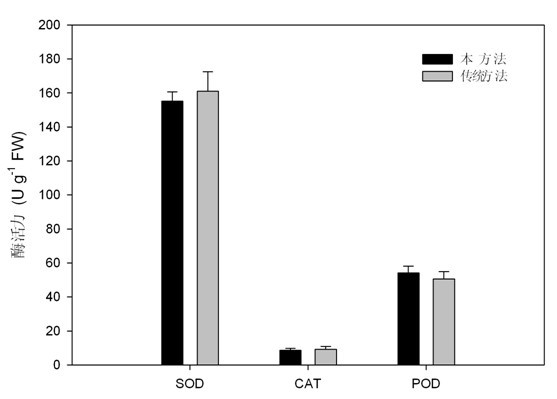Method for detecting activity of plant superoxide dismutase, catalase and peroxidase
A technology of catalase and peroxidase, which is applied in the direction of biochemical equipment and methods, and the determination/inspection of microorganisms, can solve the problems of difficult batch operation, large sample demand, time-consuming and labor-intensive, etc., and achieve high extraction efficiency , Grinding speed is fast, the effect of reducing dosage
- Summary
- Abstract
- Description
- Claims
- Application Information
AI Technical Summary
Problems solved by technology
Method used
Image
Examples
Embodiment 1
[0052] This example compares the effects of liquid nitrogen grinding method and ice bath grinding method on the extraction efficiency of SOD, CAT and POD enzymes.
[0053] Taking the detection of SOD, CAT and POD enzyme activities in potato leaves as an example, fresh potato leaves were chopped and mixed, and then ground using ice bath grinding method and liquid nitrogen grinding method to extract the phosphate buffer and phosphate buffer solution of the above three enzymes. Enzyme activity determination was carried out in accordance with traditional methods, and the experiment was set up for 6 repetitions. The specific operations are as follows:
[0054] (1) Sample grinding and enzyme extraction:
[0055] A. Ice bath grinding method: Take 1g leaves in a pre-cooled mortar, add pre-cooled 0.05mol / L, pH 7.8 phosphate buffer, grind the homogenate on ice, dilute the volume to 10 mL, and extract for 30 min. Centrifuge at 12000g for 2 minutes at 4°C, and take the supernatant that is the S...
Embodiment 2
[0062] This example is to compare the effect of a method of simultaneously extracting the above three enzymes with a phosphate buffer solution of the present invention and a traditional method of extracting the above three enzymes with three traditional phosphate buffer solutions on enzyme activity.
[0063] Taking the detection of CAT, POD and SOD enzyme activities in safflower leaves as an example, the fresh safflower leaves are chopped and mixed, and three traditional phosphate buffers are used to extract the above three enzymes and a phosphate of the present invention. The buffer solution extracts the above three enzymes at the same time, and the enzyme activity determination is carried out according to the traditional method. The experiment is set up for 6 repetitions. The specific operation is as follows:
[0064] (1) Sample grinding and enzyme extraction:
[0065] A. The three kinds of traditional phosphate buffer solutions are used to extract the above three enzymes: Take 1g...
Embodiment 3
[0072] This example uses the method of the present invention to detect the effect of low-temperature culture on the enzyme activities of SOD, CAT and POD in Houttuynia cordata leaves. The test is set to be repeated 6 times, and the specific operations are as follows:
[0073] (1) Sample grinding and enzyme extraction:
[0074] Take 1g of Houttuynia cordata leaves cultured (cultivated) at 10°C (low temperature) and 25°C (control) respectively, place them in a pre-cooled mortar, pour into liquid nitrogen and grind, and then add 10 mL of 0.2mol / L , PH 7.0 phosphate buffer solution for 30 min, centrifugation at 4 ℃, 12000g for 2 min, take the supernatant is the mixed enzyme solution of the above three enzymes;
[0075] (2) Determination of enzyme activity:
[0076] The SOD enzyme activity was determined by the nitrotetrazolium light blue method, the CAT enzyme activity was determined by the ultraviolet absorption method, and the POD enzyme activity was determined by the guaiacol method. ...
PUM
 Login to View More
Login to View More Abstract
Description
Claims
Application Information
 Login to View More
Login to View More - R&D
- Intellectual Property
- Life Sciences
- Materials
- Tech Scout
- Unparalleled Data Quality
- Higher Quality Content
- 60% Fewer Hallucinations
Browse by: Latest US Patents, China's latest patents, Technical Efficacy Thesaurus, Application Domain, Technology Topic, Popular Technical Reports.
© 2025 PatSnap. All rights reserved.Legal|Privacy policy|Modern Slavery Act Transparency Statement|Sitemap|About US| Contact US: help@patsnap.com



